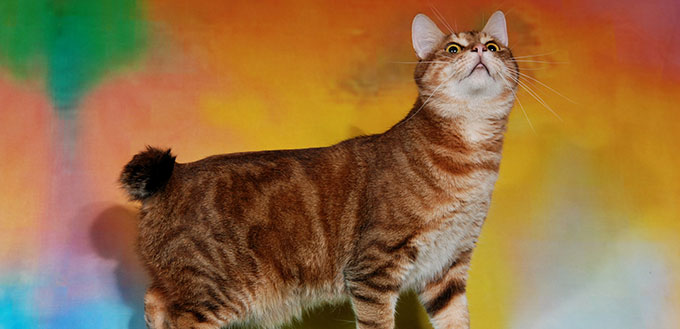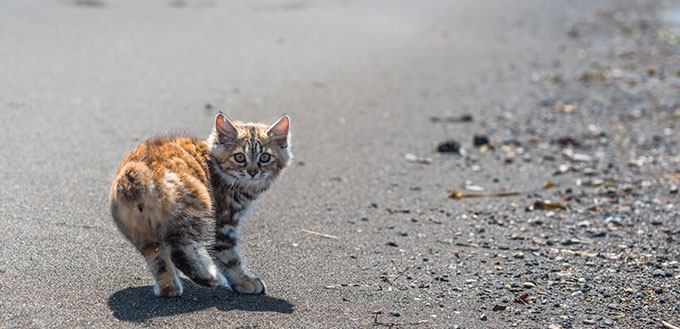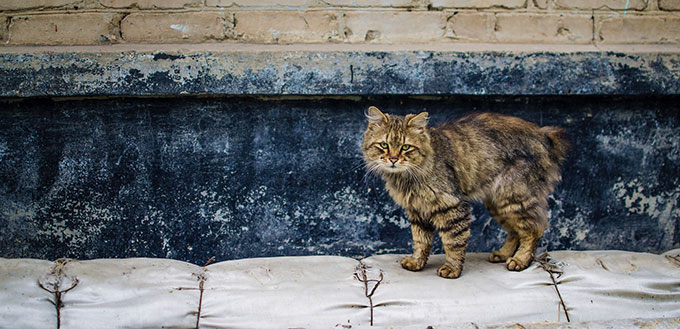The most striking thing about the Pixie-Bob cat is its resemblance to the wild Bobcat. The large breed cat retains the bobbed tail and unique markings of its wild ancestor and is ideally adapted to homes with plenty of space, including outdoor space. While loving and affectionate, the Pixie-Bob cat often needs time to settle into a home with children. It also requires an owner that has time to groom its thick coat and provide the stimulation and interaction its curious and playful nature requires.
To be recognized as belonging to the Pixie-Bob breed, a cat must meet the following breed standards provided by The International Cat Association (TICA):
- Medium to large inverted pear-shaped head topped by medium height ears that have a deep base and rounded top.
- Eyes should be medium-sized, heavily hooded, gooseberry green or golden brown in color and set under a bushy brow.
- Full broad muzzle with gently rounded, fleshy whisker pads.
- Muscular build with medium to large size torso and prominent shoulder blades
- Broad chest, deep flanks, and a primordial belly pouch.
- Long legs ending in large paws with almost round fleshy toes.
- Tail should be at least two inches long.
- Soft, wooly coat with longer belly hair. Long hair versions of the breed are breed standard.
- Coat can be any shade of brown in appearance with small to medium spotting and ticking.
In this guide to the Pixie-Bob Cat, we explore the history, characteristics, and care of these unique cats. If you are thinking about owning a Pixie-Bob cat there are several things you might want to consider, including the amount of time you will need to put into grooming and settling them in, particularly if you have children at home. By making an informed decision, you can ensure that this is the right cat for you and reduce the number of unwanted cats that are sent to rescue centers or become strays.
History of the Pixie-Bob Cat
The Pixie-Bob cat originates from the USA and is the result of selectively breeding the descendants of Bobcats and semi-domesticated barn cats. Carol Ann Brewer is the person noted as being responsible for the breed as it is recognized today. She purchased a short-tailed male kitten in 1985. The kitten was notable for its brown spotted coat and for being polydactyl, a quirk that is still part of the breed.
The following year a large classic patterned, short-tailed male that Carol Ann rescued bred with a neighbor’s domestic female. One of the resulting litter was a female kitten with a reddish-fawn coat and muted spotting. The kitten, named Pixie maintained the wild look of the Bobcats that often bred with the semi-domesticated barn cats in the area.
Carol Ann worried what would happen to the traits that these cats exhibited if she were to lose Pixie. It was this that spurred her onto breed more cats that exhibited the unique combination of spotted tabby and Bobcat traits along with the extra toes that are often found in the breed.
She approached the TICA in 1993 to begin the process of having the cats recognized as a separate breed and they were accepted for Exhibition Status in 1994 and advanced to NBC in 1995. By 1997 the breed had been granted championship status. The first International Award was won by IW SGC Silversprings Zeus.
Quick Facts About the Pixie-Bob Cat
- They are often polydactyl
Pixie-Bob cats often have extra toes, making them polydactyl. Encouraging this trait is not recommended as it can lead to problems for the domestic cat. However, having the extra toes is acceptable by the breed standard. Pixie-Bob cats can have up to seven toes and still be recognized as meeting the standard for the cat breed.
- They are curious and playful
This breed is often likened to a dog. It enjoys playing and interacting with humans and other animals. It’s curious and likes to explore its surroundings. Pixie-Bob cats can be introduced to a cat harness and leash and enjoy going for walks. The brown spotted Pixie-Bob cat does better when they have access to the outdoors.
- They need familiarizing with children
While the Pixie-Bob is a friendly cat and loves company, they do need extra time and care if they are to settle well in a household with children. It is also worth noting that they are not considered hypoallergenic.
- They come in two varieties
There is a long hair and a short-haired version of the Pixie-Bob Cat, both of which are recognized as breed standard. Both long and shorthair versions have a thick double coat that gives a wooly-like texture. The longhair cat can have a coat up to two inches in length.
Things You Should Know
Health
Pixie-Bob cats are not known to have any specific health-related issues. They are rugged short tail cats that cope well in most environments. As with all cats they need regular check-ups, flea and worm treatments, and vaccinations. There are some reports that they can be sensitive to some vaccinations, so if you are considering this breed, discuss this with your veterinarian.
Feeding
Like any domestic cat, the Pixie-Bob cat is an obligate carnivore whose primary source of nutrition comes from meat. They need a high protein diet with very little carbohydrates. Pixie-Bob cats are not known to be fussy eaters and can thrive on wet or dry cat food, or on a combination of both. It is important to feed them a high-quality food and to ensure that you follow the guidelines for their size and life stage. If you are going to feed them a raw food or home-cooked diet, then speak to your veterinarian to ensure that you are providing the right nutritional balance for your American cat.
Care
As well as the right food, veterinarian care, and regular grooming, Pixie-Bob cats need regular stimulation and interaction from their family. Access to the outdoors for them to explore is a must. They are large cats and do better in larger environments where they can indulge their curiosity.
Grooming
The Pixie-Bob cat has a double layer coat that requires daily grooming. Most Pixie-Bob cats enjoy the attention and will settle to grooming easily. Grooming is a good time to check for ticks, fleas, and other skin and coat issues.
For more help on cat grooming, you may want to check out our guides on the best cat grooming gloves, cat nail clippers, and brush for cats.
Temperament
As well as being playful and curious, the Pixie-Bob cat is known for having a laid back personality. They are often likened to dogs, not just because of their size, but also because they will seek out human attention, love to play, and can be easily leash trained. Pixie-Bob cats do tend to retain some of their more feral traits from their American Bobcat ancestors and may not be suitable for households with young children. If you are introducing a Pixiebob cat breed to children, give them plenty of time and space and ensure that the children know when to leave the cat alone. Purchasing kittens from one of the many reputable breeders is probably the best move when it comes to pets and younger children.
The Bottom Line
If you are looking for a pet that has the independent nature of a cat and the playfulness and size of a small dog, then the Pixie-Bob cat might just be for you. It is worth remembering that while they are laid back and relatively easy to care for, they do need attention and a lot of grooming. They also need time and space to adjust to children and space outdoors to explore. If you can provide for their needs, then you will gain a loving and loyal pet.
Sources:
- Meredith Hooker Williams, 5 Reasons a Pixiebob Might Be the Right Cat Breed for You, Vetstreet










